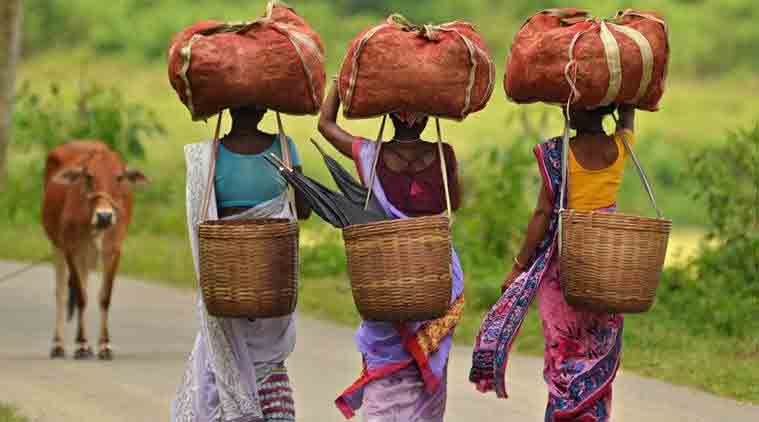
Indian Express explains why six communities in the state have been clamouring to be included in the ST list — and why those already in the tent are determined not to let them in.
The agitation to demand Scheduled Tribe (ST) status for 6 communities in Assam erupted again in a bandh last week — days after the October 15 deadline for a committee headed by Home Ministry official Mahesh Kumar Singla, looking into the demand, to submit its report passed. The Singla Committee, set up by the central government on March 1, was to originally submit its report in three months, but was given time until October 15. The Committee has consulted representatives of the 6 communities seeking inclusion in the ST list, as well as those who’re opposed to the demand.
Which are the 6 communities demanding ST status in Assam?
They are the Ahom, Koch-Rajbangshi, Moran, Matak, Chutiya and Adivasis (the so-called ‘Tea Tribes’). Currently, all of these communities are included in the OBC/MOBC list.
The Ahoms, who belong to the Tai race, ruled Assam for nearly 600 years (1228-1826), and played a major role in uniting the various ethnic communities of the Brahmaputra valley under a common Assamese identity. The Morans and Mataks, whose roots can be traced to the Hukong Valley in Burma, had migrated to Assam before the Ahoms. They faced increasing oppression from the second half of the 18th century; their situation becoming worse after the British annexed territories in Upper Assam to set up tea gardens. The Koch-Rajbangshis had their kingdom for several decades in Assam and present-day North Bengal. The kingdom of Cooch Behar joined India on August 28, 1949. The Chutiya community, the oldest among the six, is a Tibeto-Burman race which had its own kingdom for about 400 years in eastern Assam. The Adivasi ‘Tea Tribes’, comprising 96 sub-groups, are largely of Chhotanagpur origin who were brought to Assam by the British to work in tea plantations from the mid-19th century. These peoples already have ST status in the states they originally came from — in Assam, they are clubbed together as ‘Tea garden labourers, Tea garden tribes, Ex-Tea garden labourers & Ex-Tea garden tribes’.
Under what circumstances can a community be declared a Scheduled Tribe?
The Constitution does not provide a definition of a Scheduled Tribe (or Scheduled Caste). Art 366 (25) mentions “such tribes or tribal communities or parts of or groups within such tribes or tribal communities as are deemed under Article 342 to be Scheduled Tribes…” Article 342 empowers the President to specify, after consultation with the Governor, “the tribes or tribal communities… which shall… be deemed to be Scheduled Tribes” in a particular state or Union Territory, with Parliament having the right to add to or delete from the list.
As per the web site of the union Ministry of Tribal Affairs: “The criterion followed for specification of a community as Scheduled Tribes are indications of primitive traits, distinctive culture, geographical isolation, shyness of contact with the community at large, and backwardness. This criterion is not spelt out in the Constitution, but has become well established. It subsumes the definitions contained in the 1931 Census, and the reports of the first Backward Classes Commission, 1955, the Advisory Committee (Kalelkar), on Revision of SC/ST Lists (Lokur Committee), 1965, and the Joint Committee of Parliament on the Scheduled Castes and Scheduled Tribes Orders (Amendment) Bill, 1967, (Chanda Committee), 1969.”
Which communities are STs in Assam?
There are two ST lists — one for the two hill districts (Karbi Anglong and Dima Hasao), the other for the plains districts. STs in the hill districts are Dimasa Kachari, Chakma, Karbi, Garo, Hajong, Hmar, Khasi, Jaintia, Pnar, Kuki (37 subgroups), Lakher, Man, Mizo (several subtribes), Naga tribes, Pawi, Synteng and Tiwa. The ST communities in the plains districts are: Bodo, Rabha, Mising, Deuri, Hojai, Kachari (including Sonowal, Thengal), Tiwa, Mech, Dimasa, Hajong, Singpho, Hojai, Khamti and Barman (in Cachar district only).
All ST communities together comprise about 14% of Assam’s population. Of this, Bodos are 41%, Mising 17.8%, Karbi 10.7%, Rabha 8.4%, Kachari 7.1%, Tiwa 5.2%, Dimasa 3.4% and Deuri 1.2%. No break-up of population of the 6 communities demanding ST status is available.
Why are the existing STs opposed to the demand?
According to the Coordination Committee of Tribal Organisations of Assam (CCTOA), these 6 communities are educationally and economically advanced, as well as numerically significant, and there is no way the existing ST communities can compete with them. CCTOA claims giving them ST status would wipe out existing communities from elected bodies from the village council to Lok Sabha, as well as from education and jobs, and would lead to STs losing their land rights. The Committee recalls the situation in 1996, when, it says, the Centre granted ST status to the Koch-Rajbangshi community for six months, leading to the majority share of the ST quota in college admissions passing to them — 33 out of 42 MBBS seats, 17 out of 21 BE seats, all 8 BAMS seats, and 35 out of 45 BSc seats reserved for all ST communities in government colleges.
And what is the stand of the state and central governments?
The Assam government has repeatedly forwarded the case of the 6 communities to the Centre, but the Registrar General of India has turned the proposals down. The BJP, Congress and AGP are unanimous on granting them ST status. All three parties had mentioned this in their 2014 Lok Sabha and 2016 Assembly election manifestos. The central government set up the Singla Committee to consult with the state government and the agitating groups to suggest modalities for granting them ST status. Union Minister of State for Home Kiren Rijiju has said the government would change the modalities, if necessary, to include them in the ST list.
Source: Indian Express

